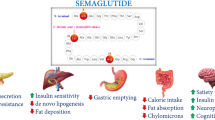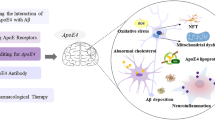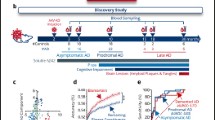Abstract
Purpose
This study was conducted to determine the relationship between mesencephalic astrocyte–derived neurotrophic factor (MANF) and lipid metabolism with or without type 2 diabetes mellitus (T2DM).
Methods
Human serum samples were collected from 58 normal controls (NC), 40 subjects with hyperlipidemia (HLD) without T2DM, and 42 subjects with HLD and T2DM. Their MANF levels were detected using an enzyme-linked immunosorbent assay (ELISA). Subgroup analysis was performed in the group with HLD and T2DM based on fasting blood glucose (FBG) > 8.22 vs. FBG ≤ 8.22. Furthermore, the relationship between MANF levels and lipid indices was analyzed.
Results
Serum MANF levels were found to be significantly higher in the HLD group, both with and without T2DM (5.62 (3.59–7.11) and 4.21 (2.87–6.11)), both P < 0.001, than in the NC (2.81(1.81–4.01). MANF levels were higher in those with FBG > 8.22 than that in those with FBG ≤ 8.22. In addition, in the HLD without T2DM group, MANF levels were negatively correlated with total cholesterol (TC), low-density lipoprotein cholesterol (LDL-C), and age, while LDL-C and age were independently related to MANF levels. The area under the curve (AUC) in the ROC analysis of MANF for the diagnosis of HLD without T2DM and HLD with T2DM was 0.709 and 0.841, respectively (P < 0.001).
Conclusion
Serum MANF levels increased in the HLD with or without T2DM groups and was associated with lipid and glucose metabolism. MANF may be a useful marker for predicting the development of dyslipidemia in T2DM.


Similar content being viewed by others
References
Hermans MP, Ahn SA, Rousseau MF (2017) The mixed benefit of low lipoprotein(a) in type 2 diabetes. Lipids Health Dis 16:171. https://doi.org/10.1186/s12944-017-0564-9
Cheng PC, Hsu SR, Li JC, Chen CP, Chien SC, Tu ST, Cheng YC, Liu YH, Kuo JF (2019) Plasma low-density lipoprotein cholesterol correlates with heart function in individuals with type 2 diabetes mellitus: a cross-sectional study. Front Endocrinol (Lausanne) 10:234. https://doi.org/10.3389/fendo.2019.00234
Vijayaraghavan K (2010) Treatment of dyslipidemia in patients with type 2 diabetes. Lipids Health Dis 9:144. https://doi.org/10.1186/1476-511x-9-144
Bekele S, Yohannes T, Mohammed AE (2017) Dyslipidemia and associated factors among diabetic patients attending Durame General Hospital in Southern Nations, Nationalities, and People’s Region. Diabetes Metab Syndr Obes 10:265–271. https://doi.org/10.2147/dmso.s135064
Ni WQ, Liu XL, Zhuo ZP, Yuan XL, Song JP, Chi HS, Xu J (2015) Serum lipids and associated factors of dyslipidemia in the adult population in Shenzhen. Lipids Health Dis 14:71. https://doi.org/10.1186/s12944-015-0073-7
Liu H, Deng X, Peng Y, Zeng Q, Song Z, He W, Zhang L, Gao G, Xiao T, Yu X (2017) Meta-analysis of serum non-high-density lipoprotein cholesterol and risk of coronary heart disease in the general population. Clin Chim Acta 471:23–28. https://doi.org/10.1016/j.cca.2017.05.006
Liao P, Zeng R, Zhao X, Guo L, Zhang M (2017) Prognostic value of non-high-density lipoprotein cholesterol for mortality in patients with coronary heart disease: a systematic review and meta-analysis. Int J Cardiol 227:950–955. https://doi.org/10.1016/j.ijcard.2016.10.106
Carratala A, Martinez-Hervas S, Rodriguez-Borja E, Benito E, Real JT, Saez GT, Carmena R, Ascaso JF (2018) PAI-1 levels are related to insulin resistance and carotid atherosclerosis in subjects with familial combined hyperlipidemia. J Investig Med 66:17–21. https://doi.org/10.1136/jim-2017-000468
Bhupathiraju SN, Hu FB (2016) Epidemiology of obesity and diabetes and their cardiovascular complications. Circ Res 118:1723–1735. https://doi.org/10.1161/circresaha.115.306825
Cnop M, Foufelle F, Velloso LA (2012) Endoplasmic reticulum stress, obesity and diabetes. Trends Mol Med 18:59–68. https://doi.org/10.1016/j.molmed.2011.07.010
Ozcan U, Cao Q, Yilmaz E, Lee AH, Iwakoshi NN, Ozdelen E, Tuncman G, Gorgun C, Glimcher LH, Hotamisligil GS (2004) Endoplasmic reticulum stress links obesity, insulin action, and type 2 diabetes. Science 306:457–461. https://doi.org/10.1126/science.1103160
Lindahl M, Danilova T, Palm E, Lindholm P, Voikar V, Hakonen E, Ustinov J, Andressoo JO, Harvey BK, Otonkoski T, Rossi J, Saarma M (2014) MANF is indispensable for the proliferation and survival of pancreatic beta cells. Cell Rep 7:366–375. https://doi.org/10.1016/j.celrep.2014.03.023
Cunha DA, Cito M, Grieco FA, Cosentino C, Danilova T, Ladriere L, Lindahl M, Domanskyi A, Bugliani M, Marchetti P, Eizirik DL, Cnop M (2017) Pancreatic beta-cell protection from inflammatory stress by the endoplasmic reticulum proteins thrombospondin 1 and mesencephalic astrocyte-derived neutrotrophic factor (MANF). J Biol Chem 292:14977–14988. https://doi.org/10.1074/jbc.M116.769877
Petrova P, Raibekas A, Pevsner J, Vigo N, Anafi M, Moore MK, Peaire AE, Shridhar V, Smith DI, Kelly J, Durocher Y, Commissiong JW (2003) MANF: a new mesencephalic, astrocyte-derived neurotrophic factor with selectivity for dopaminergic neurons. J Mol Neurosci 20:173–188
Mizobuchi N, Hoseki J, Kubota H, Toyokuni S, Nozaki J, Naitoh M, Koizumi A, Nagata K (2007) ARMET is a soluble ER protein induced by the unfolded protein response via ERSE-II element. Cell Struct Funct 32:41–50
Danilova T, Belevich I, Li H, Palm E, Jokitalo E, Otonkoski T, Lindahl M (2019) MANF is required for the postnatal expansion and maintenance of pancreatic beta-cell mass in mice. Diabetes 68:66–80. https://doi.org/10.2337/db17-1149
Fu J, Nchambi KM, Wu H, Luo X, An X, Liu D (2020) Liraglutide protects pancreatic β cells from endoplasmic reticulum stress by upregulating MANF to promote autophagy turnover. Life Sci 252:117648. https://doi.org/10.1016/j.lfs.2020.117648
Simental-Mendia LE, Rodriguez-Moran M, Guerrero-Romero F (2015) The hypertriglyceridemia is associated with isolated impaired glucose tolerance in subjects without insulin resistance. Endocr Res 40:70–73. https://doi.org/10.3109/07435800.2014.934963
Larsen S, Vigelso A, Dandanell S, Prats C, Dela F, Helge JW (2018) Simvastatin-induced insulin resistance may be linked to decreased lipid uptake and lipid synthesis in human skeletal muscle: the LIFESTAT study. J Diabetes Res 2018:9257874. https://doi.org/10.1155/2018/9257874
Morgan AE, Mooney KM, Wilkinson SJ, Pickles NA, Mc Auley MT (2016) Cholesterol metabolism: a review of how ageing disrupts the biological mechanisms responsible for its regulation. Ageing Res Rev 27:108–124. https://doi.org/10.1016/j.arr.2016.03.008
Terlemez S, Bozdemir E, Kalkan Ucar S, Kabaroglu C, Habif S, Kayikcioglu M, Coker M (2018) Insulin resistance in children with familial hyperlipidemia. J Pediatr Endocrinol Metab 31:1349–1354. https://doi.org/10.1515/jpem-2018-0337
Erratum (2016) Classification and diagnosis of diabetes. Sec. 2. In Standards of Medical Care in Diabetes-2016. Diabetes Care 39(Suppl. 1):S13–S22. Diabetes Care 39:1653. https://doi.org/10.2337/dc16-er09
Zhu JR, Gao RL, Zhao SP, Lu GP, Zhao D, Li JJ (2016) Guidelines for the prevention and treatment of dyslipidemia in Chinese adults (revised edition 2016). Chinese journal of circulation 31(10):937–953
Paulmichl K, Hatunic M, Hojlund K, Jotic A, Krebs M, Mitrakou A, Porcellati F, Tura A, Bergsten P, Forslund A, Manell H, Widhalm K, Weghuber D, Anderwald CH (2016) Modification and validation of the triglyceride-to-HDL cholesterol ratio as a surrogate of insulin sensitivity in white juveniles and adults without diabetes mellitus: the single point insulin sensitivity estimator (SPISE). Clin Chem 62:1211–1219. https://doi.org/10.1373/clinchem.2016.257436
Behiry EG, El Nady NM, AbdEl Haie OM, Mattar MK, Magdy A (2019) Evaluation of TG-HDL ratio instead of HOMA ratio as insulin resistance marker in overweight and children with obesity. Endocr Metab Immune Disord Drug Targets. https://doi.org/10.2174/1871530319666190121123535
Qujeq D, Mahrooz A, Alizadeh A, Boorank R (2018) Paraoxonase-2 variants potentially influence insulin resistance, beta-cell function, and their interrelationships with alanine aminotransferase in type 2 diabetes. J Res Med Sci 23:107. https://doi.org/10.4103/jrms.JRMS_88_18
Wu T, Zhang F, Yang Q, Zhang Y, Liu Q, Jiang W, Cao H, Li D, Xie S, Tong N, He J (2017) Circulating mesencephalic astrocyte-derived neurotrophic factor is increased in newly diagnosed prediabetic and diabetic patients, and is associated with insulin resistance. Endocr J 64:403–410. https://doi.org/10.1507/endocrj.EJ16-0472
Hakonen E, Chandra V, Fogarty CL, Yu NY, Ustinov J, Katayama S, Galli E, Danilova T, Lindholm P, Vartiainen A, Einarsdottir E, Krjutskov K, Kere J, Saarma M, Lindahl M, Otonkoski T (2018) MANF protects human pancreatic beta cells against stress-induced cell death. Diabetologia 61:2202–2214. https://doi.org/10.1007/s00125-018-4687-y
Galli E, Harkonen T, Sainio MT, Ustav M, Toots U, Urtti A, Yliperttula M, Lindahl M, Knip M, Saarma M, Lindholm P (2016) Increased circulating concentrations of mesencephalic astrocyte-derived neurotrophic factor in children with type 1 diabetes. Sci Rep 6:29058. https://doi.org/10.1038/srep29058
Bai J, Zheng S, Jiang D, Han T, Li Y, Zhang Y, Liu W, Cao Y, Hu Y (2015) Oxidative stress contributes to abnormal glucose metabolism and insulin sensitivity in two hyperlipidemia models. Int J Clin Exp Pathol 8:13193–13200
Danilova T, Lindahl M (2018) Emerging roles for mesencephalic astrocyte-derived neurotrophic factor (MANF) in pancreatic beta cells and diabetes. Front Physiol 9:1457. https://doi.org/10.3389/fphys.2018.01457
He M, Wang C, Long XH, Peng JJ, Liu DF, Yang GY, Jensen MD, Zhang LL (2020) Mesencephalic astrocyte-derived neurotrophic factor ameliorates steatosis in HepG2 cells by regulating hepatic lipid metabolism. World J Gastroenterol 26:1029–1041. https://doi.org/10.3748/wjg.v26.i10.1029
Acknowledgments
We thank the volunteers who participated in the study.
Funding
This work was supported by the National Natural Science Foundation of China (81370467).
Author information
Authors and Affiliations
Corresponding author
Ethics declarations
Ethical approval
The study was approved by the Clinical Research Ethics Committee, the Second Affiliated Hospital of Chongqing Medical University.
Informed consent
Informed consent was obtained from participants
Conflict of interest
The authors declare no conflict of interest.
Additional information
Publisher’s note
Springer Nature remains neutral with regard to jurisdictional claims in published maps and institutional affiliations.
Rights and permissions
About this article
Cite this article
Fu, J., Malale, K., Luo, X. et al. The relationship of mesencephalic astrocyte-derived neurotrophic factor with hyperlipidemia in patients with or without type 2 diabetes mellitus. Hormones 20, 537–543 (2021). https://doi.org/10.1007/s42000-021-00272-8
Received:
Accepted:
Published:
Issue Date:
DOI: https://doi.org/10.1007/s42000-021-00272-8




